Oil and Gas Industry: An Annotated Bibliography - MNG92100
VerifiedAdded on 2023/04/11
|6
|1253
|233
Annotated Bibliography
AI Summary
This annotated bibliography focuses on the oil and natural gas industry, examining its environmental impacts, economic significance, and technological advancements. It includes annotations of four journal articles discussing air quality concerns from unconventional oil and gas production, the potential for Brazil's petroleum industry to fund renewable energy, radiation hazards from TENORM waste, and the use of hydraulic fracturing. The bibliography highlights both the advantages and disadvantages of the oil and gas industry, emphasizing its importance to national economies while also acknowledging its role in environmental pollution and potential health risks. It concludes by stressing the need for precautionary measures to mitigate the negative impacts of the industry. Desklib offers this assignment solution along with a variety of study resources for students.
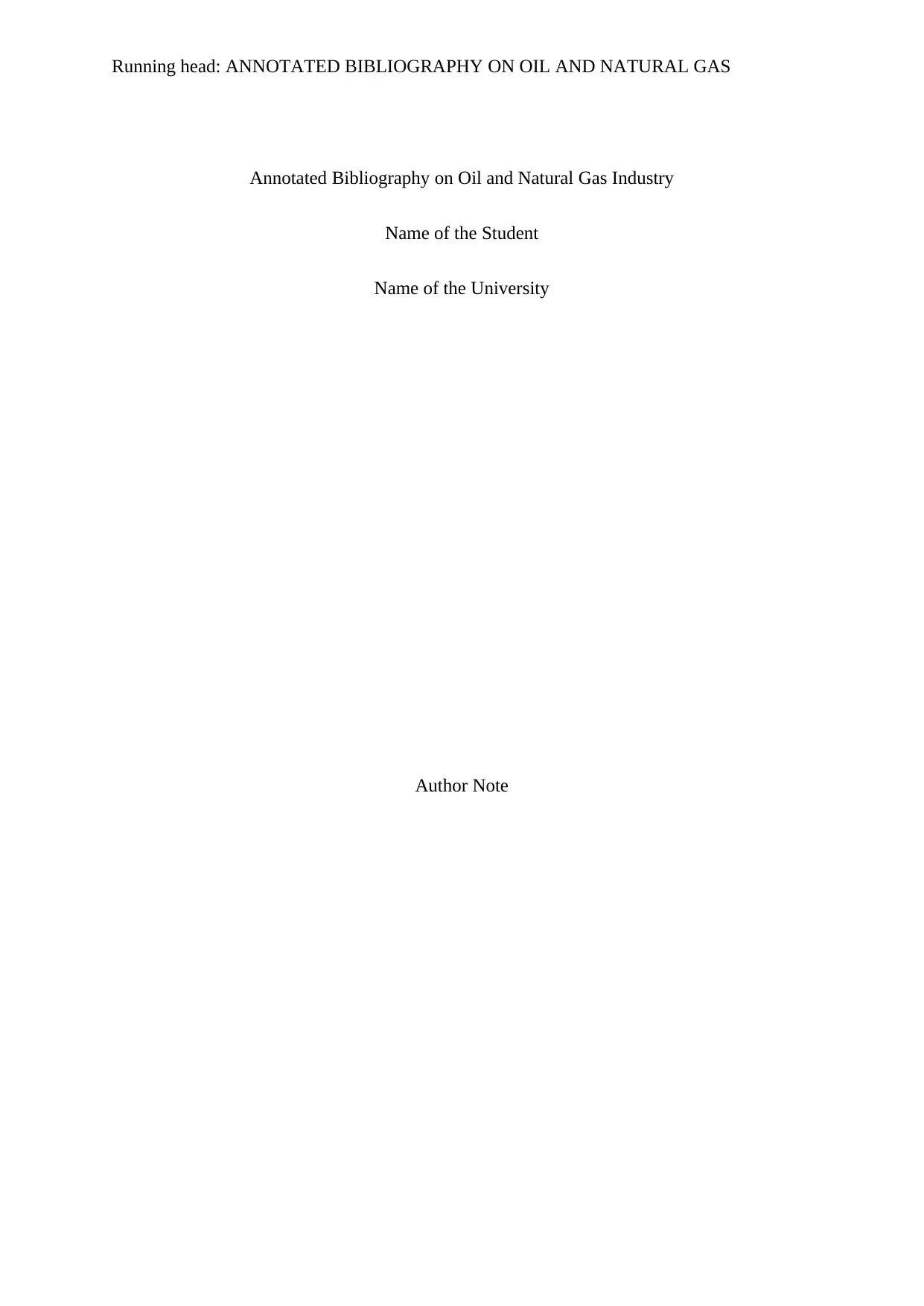
Running head: ANNOTATED BIBLIOGRAPHY ON OIL AND NATURAL GAS
Annotated Bibliography on Oil and Natural Gas Industry
Name of the Student
Name of the University
Author Note
Annotated Bibliography on Oil and Natural Gas Industry
Name of the Student
Name of the University
Author Note
Paraphrase This Document
Need a fresh take? Get an instant paraphrase of this document with our AI Paraphraser
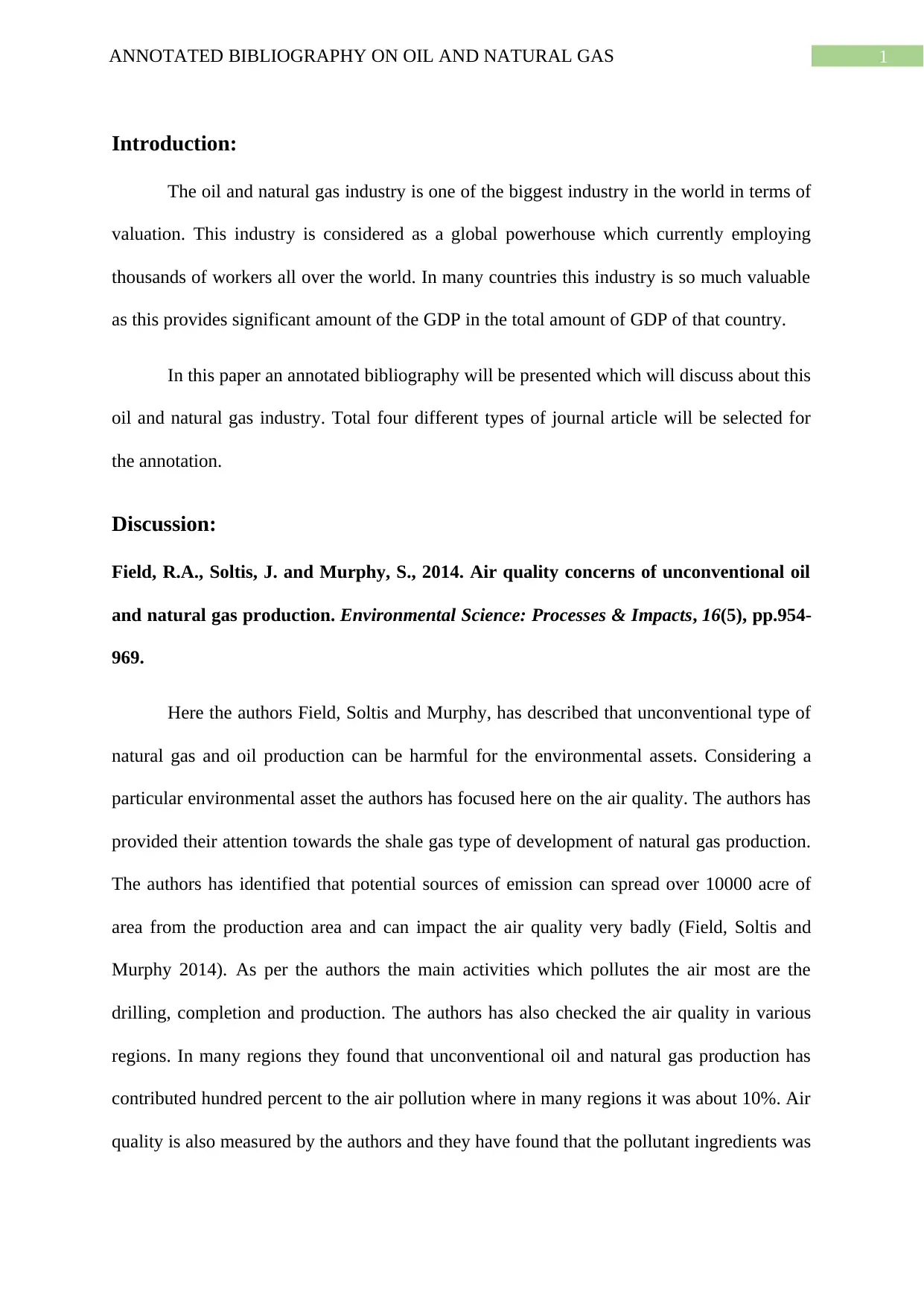
1ANNOTATED BIBLIOGRAPHY ON OIL AND NATURAL GAS
Introduction:
The oil and natural gas industry is one of the biggest industry in the world in terms of
valuation. This industry is considered as a global powerhouse which currently employing
thousands of workers all over the world. In many countries this industry is so much valuable
as this provides significant amount of the GDP in the total amount of GDP of that country.
In this paper an annotated bibliography will be presented which will discuss about this
oil and natural gas industry. Total four different types of journal article will be selected for
the annotation.
Discussion:
Field, R.A., Soltis, J. and Murphy, S., 2014. Air quality concerns of unconventional oil
and natural gas production. Environmental Science: Processes & Impacts, 16(5), pp.954-
969.
Here the authors Field, Soltis and Murphy, has described that unconventional type of
natural gas and oil production can be harmful for the environmental assets. Considering a
particular environmental asset the authors has focused here on the air quality. The authors has
provided their attention towards the shale gas type of development of natural gas production.
The authors has identified that potential sources of emission can spread over 10000 acre of
area from the production area and can impact the air quality very badly (Field, Soltis and
Murphy 2014). As per the authors the main activities which pollutes the air most are the
drilling, completion and production. The authors has also checked the air quality in various
regions. In many regions they found that unconventional oil and natural gas production has
contributed hundred percent to the air pollution where in many regions it was about 10%. Air
quality is also measured by the authors and they have found that the pollutant ingredients was
Introduction:
The oil and natural gas industry is one of the biggest industry in the world in terms of
valuation. This industry is considered as a global powerhouse which currently employing
thousands of workers all over the world. In many countries this industry is so much valuable
as this provides significant amount of the GDP in the total amount of GDP of that country.
In this paper an annotated bibliography will be presented which will discuss about this
oil and natural gas industry. Total four different types of journal article will be selected for
the annotation.
Discussion:
Field, R.A., Soltis, J. and Murphy, S., 2014. Air quality concerns of unconventional oil
and natural gas production. Environmental Science: Processes & Impacts, 16(5), pp.954-
969.
Here the authors Field, Soltis and Murphy, has described that unconventional type of
natural gas and oil production can be harmful for the environmental assets. Considering a
particular environmental asset the authors has focused here on the air quality. The authors has
provided their attention towards the shale gas type of development of natural gas production.
The authors has identified that potential sources of emission can spread over 10000 acre of
area from the production area and can impact the air quality very badly (Field, Soltis and
Murphy 2014). As per the authors the main activities which pollutes the air most are the
drilling, completion and production. The authors has also checked the air quality in various
regions. In many regions they found that unconventional oil and natural gas production has
contributed hundred percent to the air pollution where in many regions it was about 10%. Air
quality is also measured by the authors and they have found that the pollutant ingredients was
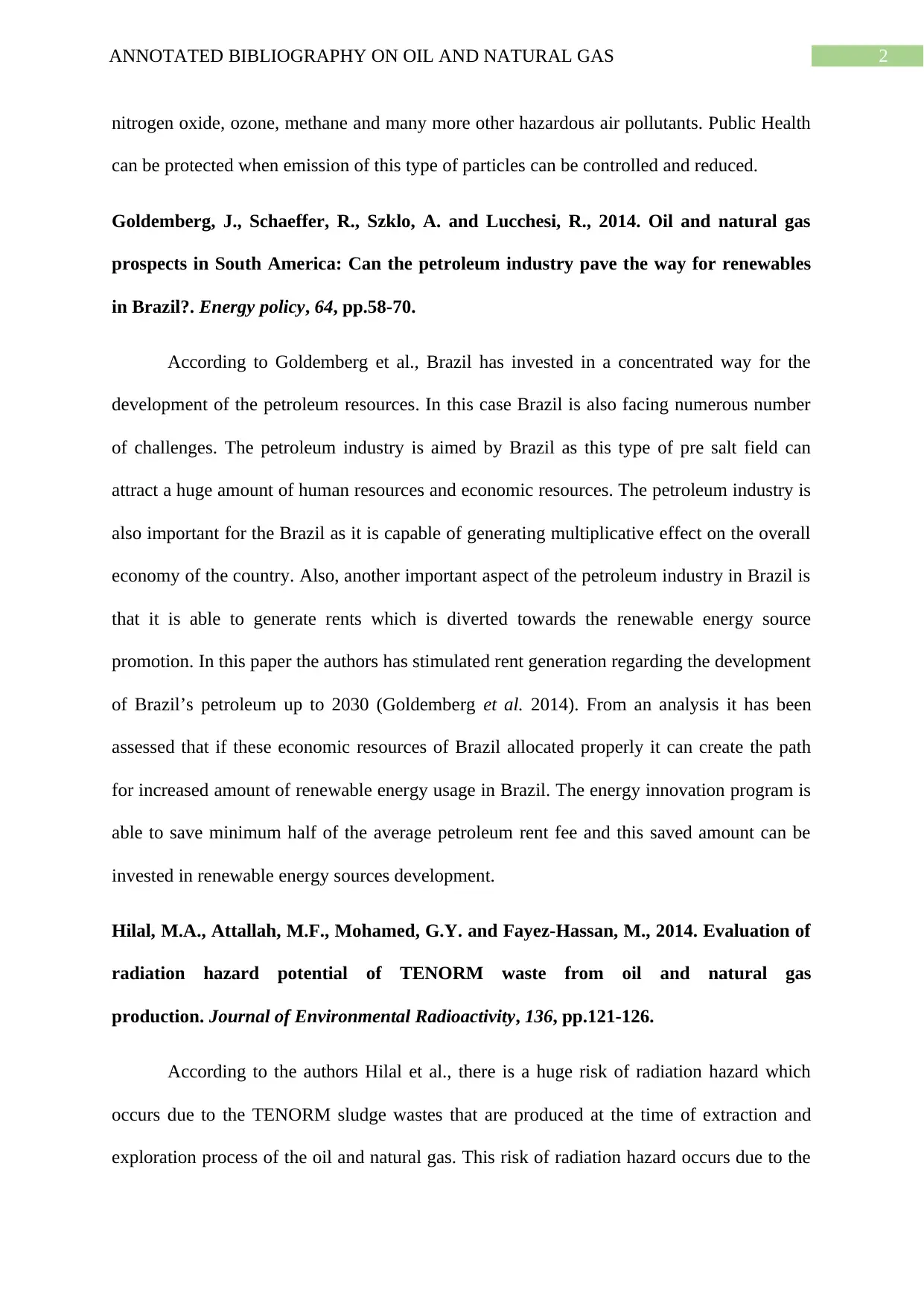
2ANNOTATED BIBLIOGRAPHY ON OIL AND NATURAL GAS
nitrogen oxide, ozone, methane and many more other hazardous air pollutants. Public Health
can be protected when emission of this type of particles can be controlled and reduced.
Goldemberg, J., Schaeffer, R., Szklo, A. and Lucchesi, R., 2014. Oil and natural gas
prospects in South America: Can the petroleum industry pave the way for renewables
in Brazil?. Energy policy, 64, pp.58-70.
According to Goldemberg et al., Brazil has invested in a concentrated way for the
development of the petroleum resources. In this case Brazil is also facing numerous number
of challenges. The petroleum industry is aimed by Brazil as this type of pre salt field can
attract a huge amount of human resources and economic resources. The petroleum industry is
also important for the Brazil as it is capable of generating multiplicative effect on the overall
economy of the country. Also, another important aspect of the petroleum industry in Brazil is
that it is able to generate rents which is diverted towards the renewable energy source
promotion. In this paper the authors has stimulated rent generation regarding the development
of Brazil’s petroleum up to 2030 (Goldemberg et al. 2014). From an analysis it has been
assessed that if these economic resources of Brazil allocated properly it can create the path
for increased amount of renewable energy usage in Brazil. The energy innovation program is
able to save minimum half of the average petroleum rent fee and this saved amount can be
invested in renewable energy sources development.
Hilal, M.A., Attallah, M.F., Mohamed, G.Y. and Fayez-Hassan, M., 2014. Evaluation of
radiation hazard potential of TENORM waste from oil and natural gas
production. Journal of Environmental Radioactivity, 136, pp.121-126.
According to the authors Hilal et al., there is a huge risk of radiation hazard which
occurs due to the TENORM sludge wastes that are produced at the time of extraction and
exploration process of the oil and natural gas. This risk of radiation hazard occurs due to the
nitrogen oxide, ozone, methane and many more other hazardous air pollutants. Public Health
can be protected when emission of this type of particles can be controlled and reduced.
Goldemberg, J., Schaeffer, R., Szklo, A. and Lucchesi, R., 2014. Oil and natural gas
prospects in South America: Can the petroleum industry pave the way for renewables
in Brazil?. Energy policy, 64, pp.58-70.
According to Goldemberg et al., Brazil has invested in a concentrated way for the
development of the petroleum resources. In this case Brazil is also facing numerous number
of challenges. The petroleum industry is aimed by Brazil as this type of pre salt field can
attract a huge amount of human resources and economic resources. The petroleum industry is
also important for the Brazil as it is capable of generating multiplicative effect on the overall
economy of the country. Also, another important aspect of the petroleum industry in Brazil is
that it is able to generate rents which is diverted towards the renewable energy source
promotion. In this paper the authors has stimulated rent generation regarding the development
of Brazil’s petroleum up to 2030 (Goldemberg et al. 2014). From an analysis it has been
assessed that if these economic resources of Brazil allocated properly it can create the path
for increased amount of renewable energy usage in Brazil. The energy innovation program is
able to save minimum half of the average petroleum rent fee and this saved amount can be
invested in renewable energy sources development.
Hilal, M.A., Attallah, M.F., Mohamed, G.Y. and Fayez-Hassan, M., 2014. Evaluation of
radiation hazard potential of TENORM waste from oil and natural gas
production. Journal of Environmental Radioactivity, 136, pp.121-126.
According to the authors Hilal et al., there is a huge risk of radiation hazard which
occurs due to the TENORM sludge wastes that are produced at the time of extraction and
exploration process of the oil and natural gas. This risk of radiation hazard occurs due to the
⊘ This is a preview!⊘
Do you want full access?
Subscribe today to unlock all pages.

Trusted by 1+ million students worldwide
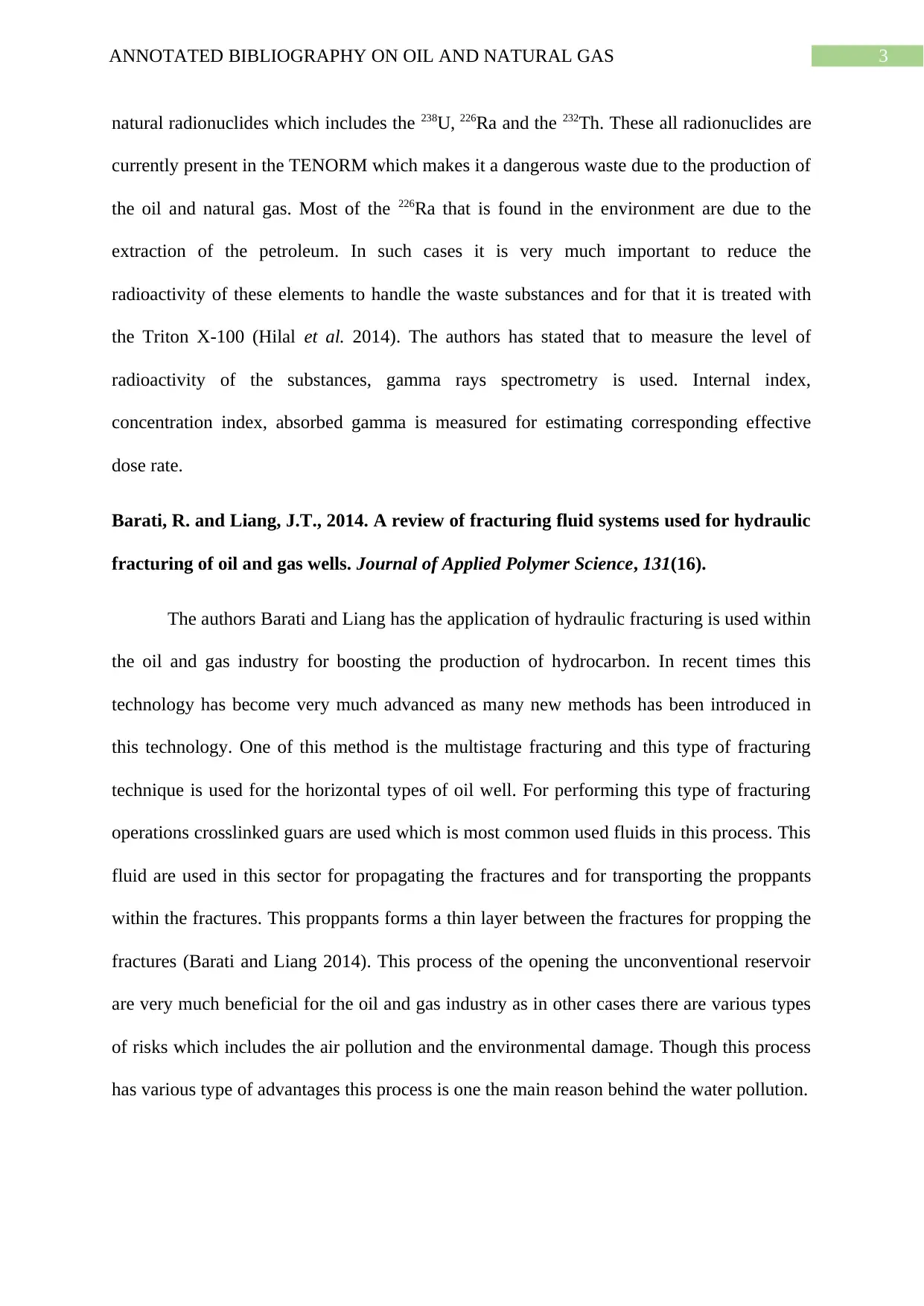
3ANNOTATED BIBLIOGRAPHY ON OIL AND NATURAL GAS
natural radionuclides which includes the 238U, 226Ra and the 232Th. These all radionuclides are
currently present in the TENORM which makes it a dangerous waste due to the production of
the oil and natural gas. Most of the 226Ra that is found in the environment are due to the
extraction of the petroleum. In such cases it is very much important to reduce the
radioactivity of these elements to handle the waste substances and for that it is treated with
the Triton X-100 (Hilal et al. 2014). The authors has stated that to measure the level of
radioactivity of the substances, gamma rays spectrometry is used. Internal index,
concentration index, absorbed gamma is measured for estimating corresponding effective
dose rate.
Barati, R. and Liang, J.T., 2014. A review of fracturing fluid systems used for hydraulic
fracturing of oil and gas wells. Journal of Applied Polymer Science, 131(16).
The authors Barati and Liang has the application of hydraulic fracturing is used within
the oil and gas industry for boosting the production of hydrocarbon. In recent times this
technology has become very much advanced as many new methods has been introduced in
this technology. One of this method is the multistage fracturing and this type of fracturing
technique is used for the horizontal types of oil well. For performing this type of fracturing
operations crosslinked guars are used which is most common used fluids in this process. This
fluid are used in this sector for propagating the fractures and for transporting the proppants
within the fractures. This proppants forms a thin layer between the fractures for propping the
fractures (Barati and Liang 2014). This process of the opening the unconventional reservoir
are very much beneficial for the oil and gas industry as in other cases there are various types
of risks which includes the air pollution and the environmental damage. Though this process
has various type of advantages this process is one the main reason behind the water pollution.
natural radionuclides which includes the 238U, 226Ra and the 232Th. These all radionuclides are
currently present in the TENORM which makes it a dangerous waste due to the production of
the oil and natural gas. Most of the 226Ra that is found in the environment are due to the
extraction of the petroleum. In such cases it is very much important to reduce the
radioactivity of these elements to handle the waste substances and for that it is treated with
the Triton X-100 (Hilal et al. 2014). The authors has stated that to measure the level of
radioactivity of the substances, gamma rays spectrometry is used. Internal index,
concentration index, absorbed gamma is measured for estimating corresponding effective
dose rate.
Barati, R. and Liang, J.T., 2014. A review of fracturing fluid systems used for hydraulic
fracturing of oil and gas wells. Journal of Applied Polymer Science, 131(16).
The authors Barati and Liang has the application of hydraulic fracturing is used within
the oil and gas industry for boosting the production of hydrocarbon. In recent times this
technology has become very much advanced as many new methods has been introduced in
this technology. One of this method is the multistage fracturing and this type of fracturing
technique is used for the horizontal types of oil well. For performing this type of fracturing
operations crosslinked guars are used which is most common used fluids in this process. This
fluid are used in this sector for propagating the fractures and for transporting the proppants
within the fractures. This proppants forms a thin layer between the fractures for propping the
fractures (Barati and Liang 2014). This process of the opening the unconventional reservoir
are very much beneficial for the oil and gas industry as in other cases there are various types
of risks which includes the air pollution and the environmental damage. Though this process
has various type of advantages this process is one the main reason behind the water pollution.
Paraphrase This Document
Need a fresh take? Get an instant paraphrase of this document with our AI Paraphraser
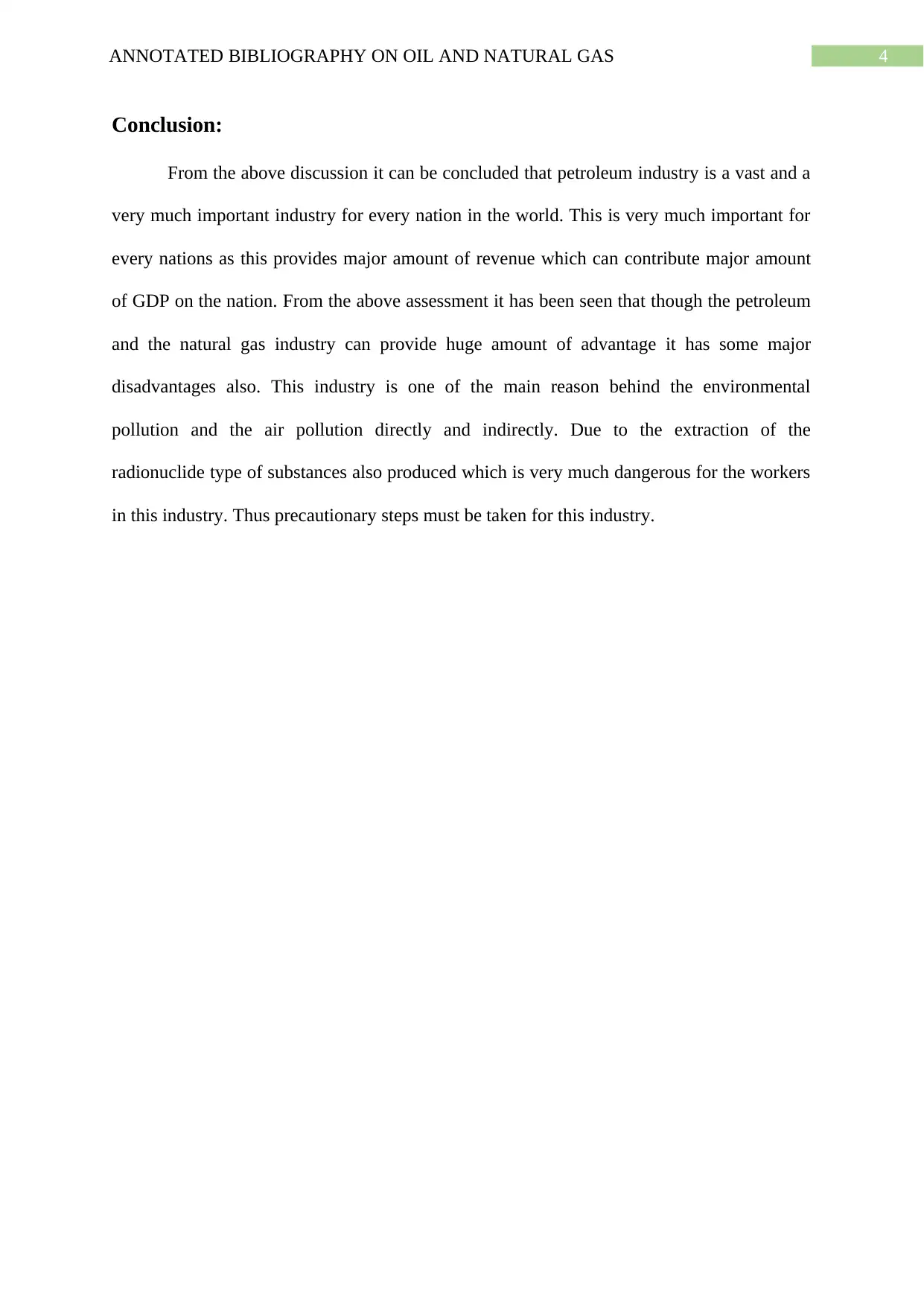
4ANNOTATED BIBLIOGRAPHY ON OIL AND NATURAL GAS
Conclusion:
From the above discussion it can be concluded that petroleum industry is a vast and a
very much important industry for every nation in the world. This is very much important for
every nations as this provides major amount of revenue which can contribute major amount
of GDP on the nation. From the above assessment it has been seen that though the petroleum
and the natural gas industry can provide huge amount of advantage it has some major
disadvantages also. This industry is one of the main reason behind the environmental
pollution and the air pollution directly and indirectly. Due to the extraction of the
radionuclide type of substances also produced which is very much dangerous for the workers
in this industry. Thus precautionary steps must be taken for this industry.
Conclusion:
From the above discussion it can be concluded that petroleum industry is a vast and a
very much important industry for every nation in the world. This is very much important for
every nations as this provides major amount of revenue which can contribute major amount
of GDP on the nation. From the above assessment it has been seen that though the petroleum
and the natural gas industry can provide huge amount of advantage it has some major
disadvantages also. This industry is one of the main reason behind the environmental
pollution and the air pollution directly and indirectly. Due to the extraction of the
radionuclide type of substances also produced which is very much dangerous for the workers
in this industry. Thus precautionary steps must be taken for this industry.
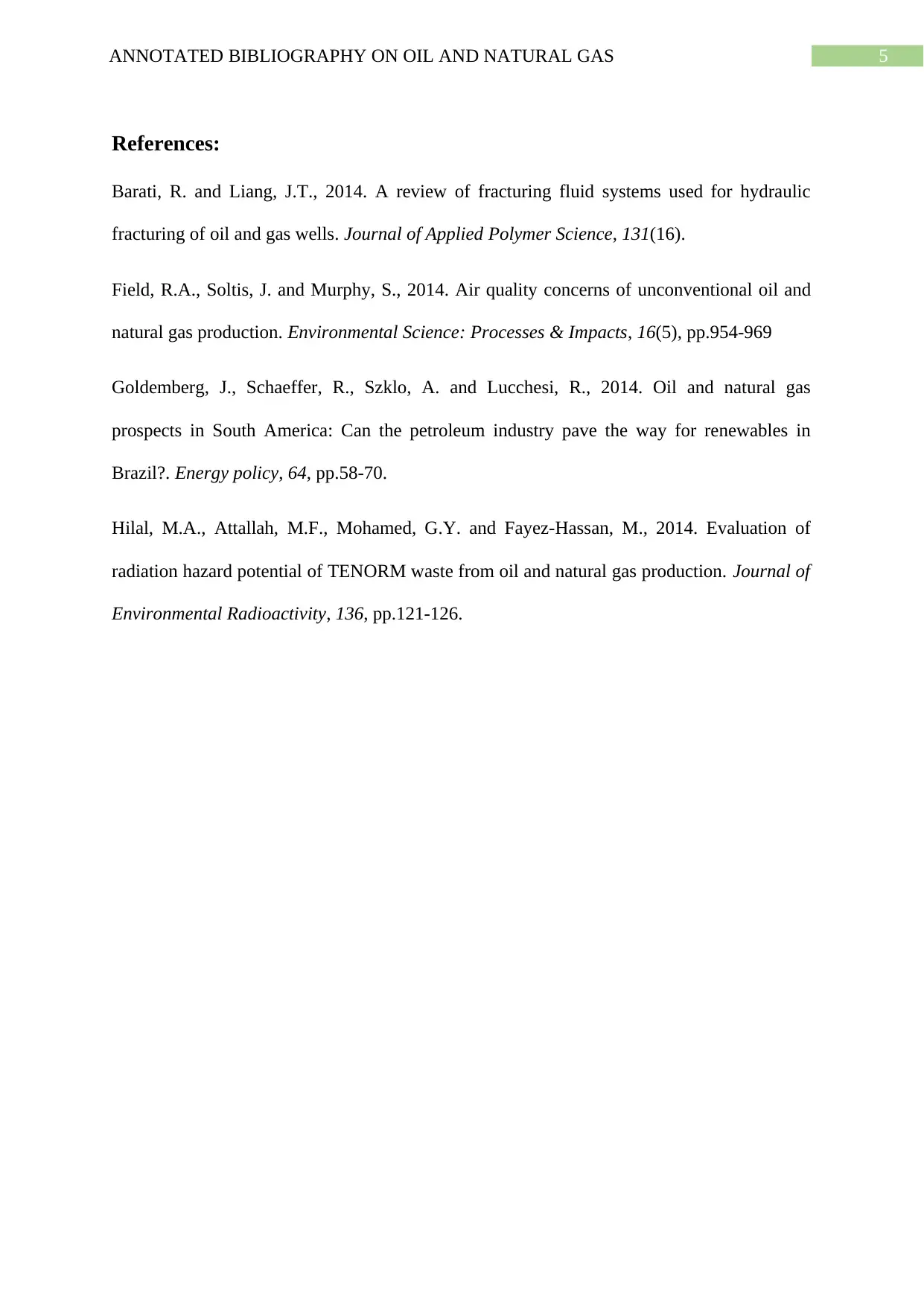
5ANNOTATED BIBLIOGRAPHY ON OIL AND NATURAL GAS
References:
Barati, R. and Liang, J.T., 2014. A review of fracturing fluid systems used for hydraulic
fracturing of oil and gas wells. Journal of Applied Polymer Science, 131(16).
Field, R.A., Soltis, J. and Murphy, S., 2014. Air quality concerns of unconventional oil and
natural gas production. Environmental Science: Processes & Impacts, 16(5), pp.954-969
Goldemberg, J., Schaeffer, R., Szklo, A. and Lucchesi, R., 2014. Oil and natural gas
prospects in South America: Can the petroleum industry pave the way for renewables in
Brazil?. Energy policy, 64, pp.58-70.
Hilal, M.A., Attallah, M.F., Mohamed, G.Y. and Fayez-Hassan, M., 2014. Evaluation of
radiation hazard potential of TENORM waste from oil and natural gas production. Journal of
Environmental Radioactivity, 136, pp.121-126.
References:
Barati, R. and Liang, J.T., 2014. A review of fracturing fluid systems used for hydraulic
fracturing of oil and gas wells. Journal of Applied Polymer Science, 131(16).
Field, R.A., Soltis, J. and Murphy, S., 2014. Air quality concerns of unconventional oil and
natural gas production. Environmental Science: Processes & Impacts, 16(5), pp.954-969
Goldemberg, J., Schaeffer, R., Szklo, A. and Lucchesi, R., 2014. Oil and natural gas
prospects in South America: Can the petroleum industry pave the way for renewables in
Brazil?. Energy policy, 64, pp.58-70.
Hilal, M.A., Attallah, M.F., Mohamed, G.Y. and Fayez-Hassan, M., 2014. Evaluation of
radiation hazard potential of TENORM waste from oil and natural gas production. Journal of
Environmental Radioactivity, 136, pp.121-126.
⊘ This is a preview!⊘
Do you want full access?
Subscribe today to unlock all pages.

Trusted by 1+ million students worldwide
1 out of 6
Related Documents
Your All-in-One AI-Powered Toolkit for Academic Success.
+13062052269
info@desklib.com
Available 24*7 on WhatsApp / Email
![[object Object]](/_next/static/media/star-bottom.7253800d.svg)
Unlock your academic potential
Copyright © 2020–2025 A2Z Services. All Rights Reserved. Developed and managed by ZUCOL.





